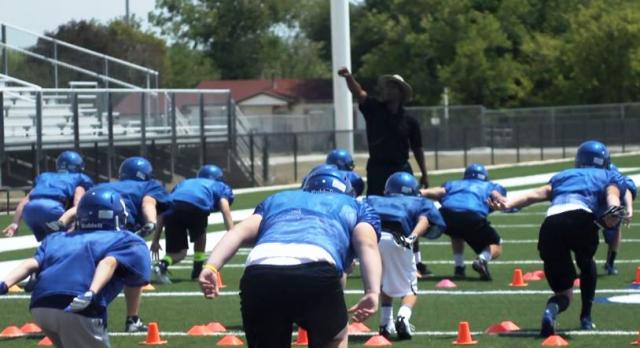Limiting or eliminating contact practices in football would result in an 18% to 40% reduction in head impacts respectively over the course of a high school football season, reports a new study, [1] which says that, until the risk factors for chronic traumatic encephalopathy (CTE) are better defined, and research shows that reducing the time spent learning to tackle in practice will not lead to increased risk of concussions in games, policymakers should proceed with caution in imposing such limits.

While describing the goal of reducing the overall number of head impacts that high school football players sustain in a season as "logical" and "appealing," lead author, Steven P. Broglio, PhD, ATC, of Michigan NeuroSport and Director of the NeuroSport Research Laboratory at the University of Michigan, concluded that, "until the risk factors for CTE are better defined by carefully designed and controlled research," and research determines "what the advisable limit to head impact exposure should be," employing contact limits or establishing "hit counts" will remain "educated guesses, at best."
Limits are controversial
Repetitive, low-impact hits (i.e. sub-concussive impacts) have been linked in a number of recent studies in football, [2-5] hockey, [4] and soccer [6] to short- and possibly long-term brain damage. Given the potentially large number of head impacts a high school football athlete may experience over the course of the season and their career, some experts have suggested implementing head impact monitoring and impact limitation strategies similar to pitch counts in baseball.
Until technology makes it practical and feasible to equip cash-strapped football teams with low-cost sensors to measure the number, direction and force of head impacts during games and practices, some have suggested reducing the number of contact practices permitted each week as a way of reducing athletes' overall head impact burden.
In response, limits on full-contact practices have begun to implemented at every level of football, from the National Football League to college football (i.e. Ivy League, and Pac-12) to the high school level (Arizona, Washington State, Iowa, and Texas have all recently moved to limit the number of full-contact practices, either in spring football or during the regular season), and down to the youth level (Pop Warner). All are intended to limit the amount of total brain trauma football players sustain as a result of repetitive sub-concussive hits.
While the recent movement to limit full-contact practices is intended to make the game safer, some experts agree with Broglio that caution should be the byword. A March 2013 review of current risk-reduction strategies in the British Journal of Sports Medicine [7] reminds state high school athletic associations and legislatures that, in enacting rules such as limits on full-contact practices, they "need to carefully consider potential injury 'trade-offs' associated with the implementation of injury-prevention strategies, because every change may have certain advantages and disadvantages. That is, by reducing one risk or danger, additional risks may be created." In other words, as the Michigan study points out, limits on full-contact practices could create additional risk of injury to players because they haven't spent enough time learning to tackle properly.
Anecdotal evidence suggests that at least some high school football players are against limiting full-contact practices for much the same reason. A completely unscientific survey of Newcastle (OK) players during the filming of the concussion documentary, "The Smartest Team," suggest that they were concerned that it might expose them to more, not less injuries. One told producer and director Brooke de Lench that he felt that "if you went out at practices, didn't have contact, didn't have near the amounts of impacts you receive in the game, it would almost be a surprise to you when you got to Friday night."
Time to rethink way tackling taught?
Not surprisingly, there are those who believe limits on full-contact practices, taken too far, could do just that, among them experts like Coach Bobby Hosea, whose heads-up tackling technique is being implemented at all levels of the game. [8] As Hosea observes about practice, "If you want to be better at playing an instrument, you need more practice, not less. A new lanquage? More not less. So, why are we limiting practice?"
While recognizing that less tackling practice may reduce the over all number of head impacts, Hosea suggests that, "without changing the way tackling is taught, nothing will change. Only practicing smarter will." Hosea argues that "teaching athletes proper tackling mechanics that keep the head out of the collision will eliminate impacts to the head altogether."
As Coach Hosea says in the PBS documentary, "The Smartest Team: Making High School Football Safer,", It's "time to have a standardized tackling progression all across the board. Right now tackling is a ‘Heinz 57' approach. Whatever your grandfather taught your dad, that's what you're teaching them. But we know now, that's antiquated. There's things that are dangerous. So number one, educate the coaches."
He points out that the Michigan study suggests that players were still learning to tackle the old-fashioned way, referring at one point to the fact that non-contact practice sessions centered on player technique and plays with athletes "wrapping up" their opponent. Ironically, claims Hosea, athletes "wrapping up" their opponents is the actually the "primary reason" helmet-to-helmet contact occurs in the first place. "Eliminating that instruction will eliminate crown-first impacts from practice and games," he argues. Another way to cut down on the number of hits to the head in practice, he to use tackling dummies and blocking sleds while learning to tackle, instead of live players.









